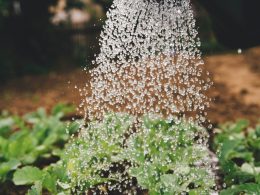Are you a beginner looking to start your very own flower garden? Well, get ready for an exciting adventure! A flower garden not only adds beauty and color to your outdoor space but also provides a relaxing and therapeutic hobby. But where do you begin? Don’t worry! In this guide, we’ll take you through the basics of starting a flower garden from seed to bloom. So grab your gardening gloves and let’s get started!
What is a Flower Garden?
A flower garden is a planned outdoor space for growing and displaying different types of flowers. It can be as small or large as you desire, from a few pots on your balcony to an extensive landscape in your backyard. Flower gardens provide numerous benefits, such as improving air quality by increasing oxygen levels and reducing carbon dioxide levels.
Moreover, they attract pollinators like bees, butterflies and hummingbirds that help fertilize plants while also adding movement and beauty to the garden. Additionally, having a flower garden provides an opportunity for exercise, mental relaxation and stress reduction.
Flower gardens come in many shapes and sizes with diverse plant selections depending on personal preferences or climate conditions. They can be designed according to themes like color schemes (monochromatic or contrasting), seasons (spring bulbs or autumn foliage) or specific purposes (cut flowers arrangements). Whatever style you choose, a flower garden has something unique to offer everyone!
The Different Types of Flowers You Can Grow
When it comes to starting a flower garden, the options can be overwhelming. There are so many different types of flowers to choose from, each with their own unique characteristics and requirements.
Annuals are a popular choice for beginners because they grow quickly and provide beautiful blooms all season long. Some common annual flowers include marigolds, petunias, and zinnias.
Perennials are another option that can add color and beauty to your garden year after year. Examples of perennials include daisies, irises, and daylilies.
Bulbs also make great additions to a flower garden as they often produce large, showy blooms. Tulips, daffodils, and lilies are just a few examples of bulbs you can plant in your garden.
If you’re looking for something more low-maintenance or drought-resistant, succulent plants like cacti or sedums may be the way to go.
No matter which type of flower you choose for your garden, be sure to research its specific needs for soil type, sunlight exposure, watering habits etc., before planting. This will help ensure that your flowers thrive in their new environment!
How to Choose the Right Flowers for Your Garden
When it comes to choosing the right flowers for your garden, there are a few things you should consider. First, think about the amount of sunlight and shade your garden receives throughout the day. Some flowers require full sun exposure while others thrive in partial or full shade.
Next, consider the climate in which you live. Certain types of flowers may not be able to withstand extreme heat or cold temperatures. It’s important to choose plants that can tolerate your local weather conditions.
Another factor to keep in mind when selecting flowers is their maintenance requirements. Do you have time and resources to care for high-maintenance blooms? Or would you prefer low-maintenance plants that still add color and beauty to your garden?
Pick colors and varieties that complement each other well. You want a cohesive look for your flower bed rather than a mishmash of random blooms.
By taking these factors into account, you’ll be sure to choose beautiful and thriving flowers that will make any beginner gardener proud!
How to Deal with Pests in a Flower Garden
One of the biggest challenges when it comes to flower gardening is dealing with pests. These tiny creatures can wreak havoc on your garden and damage your precious flowers.
The first step in dealing with pests is identifying them. You need to be able to recognize what type of pest you’re dealing with before you can take any action.
Once you’ve identified the pest, research the best ways to get rid of it. There are a variety of methods available, from natural remedies like neem oil or insecticidal soap, to chemical treatments.
Another way to prevent pests from invading your garden is by using companion planting techniques. Certain plants have natural repellent properties that deter common garden pests.
It’s also important to maintain good hygiene practices in your garden. This means regularly removing dead plant material and weeds which can harbor insects and diseases.
If all else fails, don’t be afraid to call in professional help. Sometimes an infestation may require more specialized attention than you’re equipped to handle on your own.
By taking these steps, you’ll be well-equipped in dealing with any pesky critters that come your way while maintaining a healthy, thriving flower garden for years to come!
When to Harvest Your Flowers
When it comes to harvesting flowers, timing is everything. Harvesting at the right time will ensure that your flowers are fresh and vibrant for as long as possible.
Different types of flowers have different requirements when it comes to harvesting. For example, annuals like marigolds should be harvested regularly throughout the growing season, while perennials like coneflowers should only be harvested once or twice a year.
One way to know if your flowers are ready for harvest is by looking at their petals. If they are fully open and not showing any signs of wilting or discoloration, then they are likely ready to be picked.
Another thing to consider is the time of day. Early morning or late afternoon is generally the best time to harvest because the temperature is cooler and there’s less risk of heat stress on the flower.
When you do start harvesting your flowers, make sure you use sharp scissors or pruning shears so that you don’t damage the stem. Cut just above a set of leaves so that new growth can continue from there.
Knowing when to harvest your flowers takes some practice and observation but with patience and care, you’ll soon become an expert in getting those perfect blooms!
Conclusion
Starting a flower garden may seem like a daunting task, but with the right information and tools, anyone can do it. Remember to choose the right flowers for your space and climate, prepare your soil properly, water regularly, and deal with pests as soon as you notice them.
Starting a flower garden is not just about growing beautiful blooms but also about connecting with nature and taking care of our environment. By planting pollinator-friendly plants and using eco-friendly practices in our gardens, we are contributing to the preservation of our planet.
So don’t be afraid to get started on your own flower garden journey. With patience, dedication, and some trial-and-error along the way, you’ll soon have a colorful paradise blooming in your backyard!










